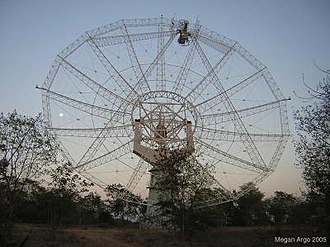Science and observations
One of the aims for the telescope during its development was to search for the highly redshifted 21-cm line radiation from primordial neutral hydrogen clouds in order to determine the epoch of galaxy formation in the universe. [7]
Astronomers from all over the world regularly use this telescope to observe many different astronomical objects such as the Sun, Jupiter, exoplanets, magnetically active stars, microquasars or binary stars with a compact object (neutron star or black hole) as companion, pulsars, supernovae, supernovae remnants (SNR) HII regions, galaxies, quasars, radio galaxies, clusters of galaxies, cluster radio relics and halos, high-z galaxies, solar winds, Inter-galactic HI absorption lines, diffuse radio emission from filaments of galaxies, possible signs of time-variation of fundamental constants, variation of gas content with cosmic epoch, epoch of reionisation etc. . [3] [6]
GMRT has produced an all sky survey named TIFR GMRT Sky Survey (TGSS). Nearly 90% of the sky has been imaged at the frequency of 150 MHz (wavelength 2m), with an angular resolution of 25 arc second and rms noise of 5 mili Jansky per beam. Source Catalogue and FITS image files for the scientific community are freely available. [8] General public and citizen scientists can see 150 MHz image of any, supernova remnant, spiral galaxy or radio galaxy with its name or position at the RAD@home RGB-maker web-tool. Power and versatility of the GMRT has led to a renaissance in the field of low frequency radio astronomy. [9]
From this, TGSS survey, data, in August 2018, the most distant known radio galaxy : TGSS J1530+1049, located at a distance of 12 billion light years, was discovered by GMRT. [10] [11]
In February 2020, it helped in the observation of evidence of the largest known explosion in the history of the universe, the Ophiuchus Supercluster explosion. [12]
In January 2023, the telescope picked up a radio signal (21 cm line emission from neutral atomic hydrogen gas) which originated from 8.8 billion light years away. [13]
This page is based on this
Wikipedia article Text is available under the
CC BY-SA 4.0 license; additional terms may apply.
Images, videos and audio are available under their respective licenses.






